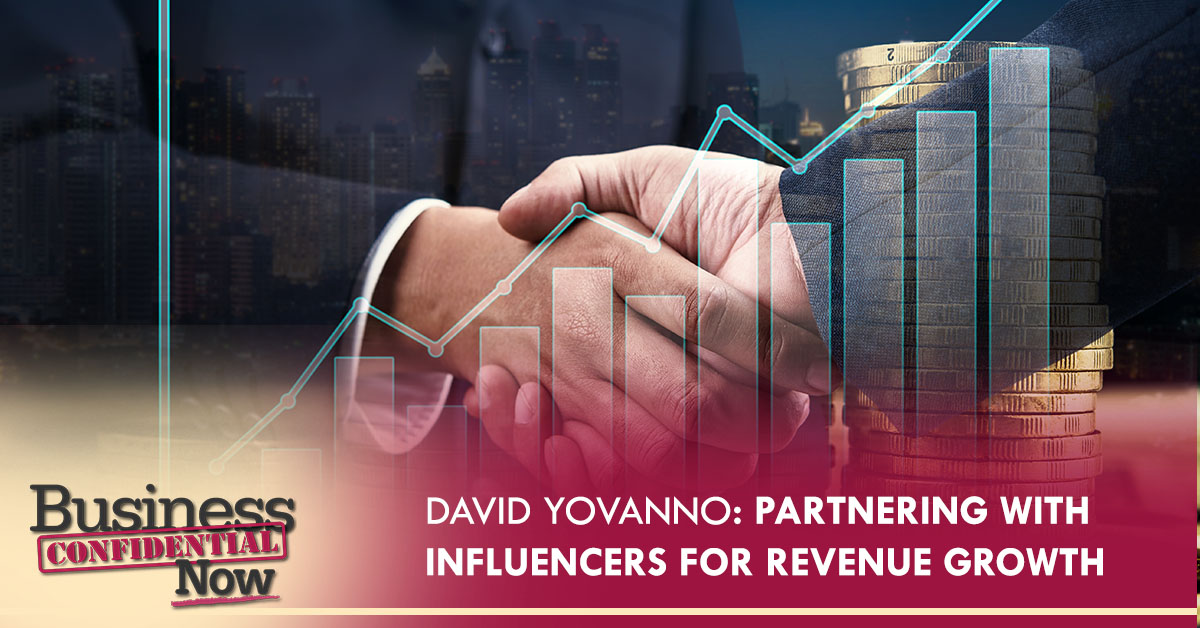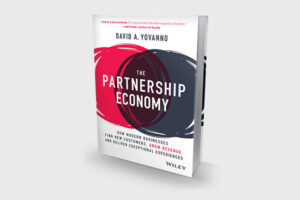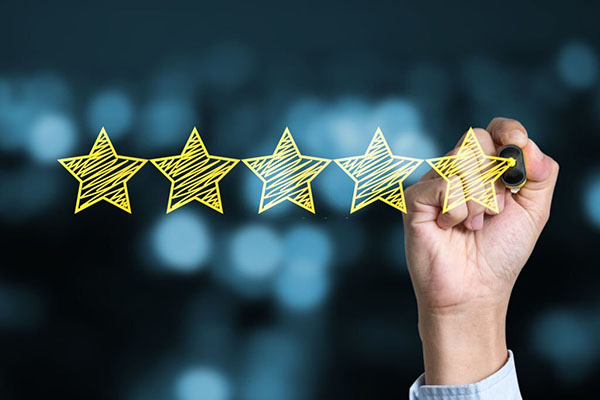
Photo Credit: @ iStock Credit: Totojang
The world is constantly changing and businesses need to adapt. It’s getting harder because customers talk online a lot. What are strategies you can formulate to promote your brand well? Partnering with influencers to attract customers is a great way to build your business and widen your reach. Join your host Hanna Hasl-Kelchner as she talks with David Yovanno on how you can choose the right influencers for your organization. David is the CEO of impact.com, the global standard partnership management platform that makes it easy for businesses to create, manage, and scale an ecosystem of partnerships. In this episode, he shares in-depth insights on buyer decisions and delivering value through advertising. Learn how to grow your business and revenue far beyond expectations!
—
What You’ll Discover About Partnering With Influencers
- Is traditional advertising dead?
- How social publishing platforms changed consumer behavior
- How to find the right influencers to partner with and how to create partner programs
- Why partnering with influencers is becoming mainstream and how you can find opportunities in this space
- Why partnerships are a third category next to sales and marketing
- How to respect creators/influencers in your partnership
—
—
Guest
 David A. Yovanno is the CEO of impact.com, the global standard partnership management platform that makes it easy for businesses to create, manage, and scale an ecosystem of partnerships with the brands and communities that customers trust to make purchases, get information, and entertain themselves at home, at work, or on the go. Dave and impact.com have been pioneers in establishing partnerships as a third channel for scalable and resilient revenue growth alongside sales and marketing.
David A. Yovanno is the CEO of impact.com, the global standard partnership management platform that makes it easy for businesses to create, manage, and scale an ecosystem of partnerships with the brands and communities that customers trust to make purchases, get information, and entertain themselves at home, at work, or on the go. Dave and impact.com have been pioneers in establishing partnerships as a third channel for scalable and resilient revenue growth alongside sales and marketing.
Dave has provided strategic leadership to SaaS companies in the technology vertical for more than two decades, previously serving as CEO of Marin Software, a San Francisco-based global leader in paid search SaaS technology; as president of technology solutions at Conversant, a diversified marketing services company; and as CEO of Gigya, a customer identity management platform. He has also served on the board of the Interactive Advertising Bureau and as a lieutenant and CIO in the United States Navy.
—
David Yovanno: Partnering With Influencers For Revenue Growth
Partnering with influencers to attract customers is fast replacing mad men-type ads and jingles. Our guest says almost half of the consumers depend on recommendations, not ads, before making a decision to buy. How can your business jump on the influencer and partnering bandwagon to get the word out about your terrific product or service? Our guest has some answers.
—
I’ve got a great show for you. My guest is David Yovanno. He’s the Partnership Automation Expert and a CEO of Impact.com where he’s been a pioneer in establishing partnerships as a third channel for scalable and resilient revenue growth, alongside sales and marketing. He’s also the author of the book, The Partnership Economy: How Modern Businesses Find New Customers, Grow Revenue, and Deliver Exceptional Experiences, where he explains why traditional advertising is failing, why partnerships are the future, and what this means for you and your customers. It’s such an important topic for businesses interested in growth who don’t want to waste their time or their valuable advertising dollars, so let’s dive in. Welcome to the show, Dave.
Thanks for having me. I’m looking forward to it.
Thank you for being here. The subtitle of your book, How Modern Businesses Find New Customers, Grow Revenue, and Deliver Exceptional Experiences, is intriguing. What is it about partnering with influencers that are better than traditional advertising? Is old-school advertising really dead?
I didn’t think about it until you mentioned it, but it does nail it. It’s hard to find customers nowadays. If you think about why that is, I would say it starts with number one, there’s a lot of consumerism now. As an economy, especially in the US, people are buying a lot of stuff. Maybe the pandemic accelerated that, people sitting at home. Maybe it was a little bit of subsidy money to work with, but certainly bored searching around the internet and researching things online and buying. My theory is that it’s led to that dopamine effect. When you come home and there’s a package waiting for you, there’s that chemical reaction where you’re excited or upset if it’s not there and you expected it to be there. It’s similar to when you post something on social media, you’re waiting for somebody to like or comment on something that people can talk about.
The same thing is happening with shopping. There’s a lot more choice of things to buy out there now as well. Shopify, for example, is one of the big eCommerce platforms that allow you to open up a store. If you go back several years ago, there were about 40,000 stores on their platform. There are 2 million stories on that platform right now. There’s a lot of noise out there, buying happening, and a choice of things to buy. It’s getting harder and harder for brands to cut through that noise and reach people. What we would all agree with is that a lot of the buying behavior that happens now, it’s less about what brands are saying directly to the buyer and it’s more about what other people are saying about you. That’s the primary path of making decisions about what to buy and where to buy as other people are saying.

The Partnership Economy: How Modern Businesses Find New Customers, Grow Revenue, and Deliver Exceptional Experiences
I understand where that’s coming from. That’s good news and bad news. There was something about those advertising jingles that keep repeating in your head over and over again, like an earworm, which something has gotten lost. Your point is well taken about people going on recommendations.
Think about that. That’s worth unpacking if you allow me. If you go back for years, like the early 1900s, there’s one radio started and then in that same year, the first TV station came out. Think about what it was like back then. We’re all sitting around the same radio stations and then all the same few TV stations. What happened when the media started? It was just a few choices of channels because it was so expensive, and a few advertisers. To your point, we’re all saying the same jingle, running out, and buying the same products that we were told to go buy. There was no check and reference of the quality, and what’s the best option. There certainly weren’t as many options as there were back then as there are now. You fast forward to the age of the internet and then the rise of the social publishing platforms. We’re in a situation now where there’s a spin of free and open access to fully transparent information about what’s real and what’s not.
Again, going back many years ago, what were those early ads? Think about it, it’s almost laughable. 4 out of 5 doctors say it’s okay to smoke and do other crazy things. People feel like they’ve been lied to for a number of years. With the rise of the social platforms, YouTube, Instagram, TikTok, vlogs, and major publications now are putting a lot of time and effort into rating, reviewing, and talking about products. They’re talking with a high degree of authenticity, transparency, and truth. There’s a lot more of that information out there now.
This has been building in the last few years. It is when this critical mass of commercial-based information and content has been democratized and readily available on some of these social publishing platforms. The modern consumer is trained to go seek out information and find out what’s real. What’s the real deal about this product? Maybe I saw an ad, maybe I didn’t, but I am going to go do my research to see what other people have to say about it before I buy. That’s the main point that we’re making. What we’re trying to inspire businesses to realize is that your new path, the modern consumer is forming an alliance with these creators of information.
Spend time with them, inform them, and get them to be a partner with you, so that they’re presenting accurate information about yourself. Provide links for them to go shop and purchase with you. If you do that, you’re able to credit them for the sale. It’s like an outsource sales team almost. You can pay them a commission or a fixed fee. There are lots of different ways to do it. Technology, like my company, Impact.com, helps allow you to scale that and manage that all. This is the modern way to cut through and be relevant.
What other people are saying about you is the primary path people take when making decisions about what to buy. Share on X
This is the modern way. We want to be modern to be able to reach the consumers who want our products and services. Check. I got that. Let’s say I’m new to this. How do I go about partnering with influencers to make these alliances? How do you find the right ones?
It does sound overwhelming because it is new. When you look at the rising ad rates on platforms like Facebook and some of the other popular places to run ads, Google, Snapchat, and a few others, Amazon has been an increasing place there to run ads. A lot of businesses are forced to figure this out. Your ad rates on these top platforms where you have to trust them to do all the targeting, tracking, and measurement now, because with a block of IDFA with Apple devices. Google is doing its way with their cookie. You’ve probably read a lot about some of the restrictions now to what you can track and can’t track online now.
Ad rates have gone up as a result of all that. This is half to figure this out. It sounds overwhelming, but it’s not. To answer your question, it starts with following the path of your customers or your prospective customers. I would encourage you to ask them like, “What are other sources of information you looked at before buying my product?” There’s a chapter in the book, Chapter 5. It’s called The Six Building Blocks of Building Your Program Here. It starts with understanding your ideal customer profile and where they source information before purchasing your product or compatible products, like complimentary products. They’re buying from other businesses. They’re sourcing other information. Find those sources out and go talk to those sources because those sources are your potential partners.
What you’re looking for is, do you share the same customer profile? Are you compatible? Is there a brand fit? Is there an opportunity to integrate with each other and refer to each other business in different ways? That’s the start of your partner program. As it gets to scale, then you can think about the technology that you might need to automate some of those things, but it starts with talking to your customers and finding out how they’re sourcing information, what are other complimentary products, and then forming a conversation with those prospective partners.
How do you make sure that partnering with influencers dovetails and supports your business goals? What do you look out for? It’s one thing to say to talk to your customers. In some businesses, that may be easier to do than others.

Partnering With Influencers: It’s hard to find customers today. There’s just a lot of consumerism today. People are just buying a lot of stuff. The pandemic accelerated that.
If we unpack that a little bit deeper, that’s the chapter of the Six Building Blocks or Chapter 5. Let me give you an example. We have two customers that I’m looking at here in this example. One is a company called Winc. They sell direct-to-consumer wine subscriptions. There is another business called Sunbasket. They are a direct-to-consumer pre-made meals service that some of your audience members have heard of, where you get a box of meal components, you put some things together, you heat it up, and you have your meal that’s on a basket. They have a partner program with creators and people that talk about great ways to get meals or wine delivered up to your home.
There are a lot of wine enthusiasts, creators, and influencers out there. There are blogs. Food & Wine is a major magazine of the Meredith brand that talks about the best subscription. That’s part of their program, but they’re also partners with each other. What they do is they insert with each other. If I’m a Sunbasket subscriber, I get my meal and there’s this little postcard thing that comes with the meal. It says, “We thought you might enjoy some wine with your meal. We’re partnered with Winc. We’ve toured their facilities. We see how they manufacture their wine, how they source their ingredients, and how they treat their employees. This is a business that has a value that matches ours. Use this code. Maybe you’ll get a discount on their wine subscription. Have a glass of wine on us.”
Winc is doing the exact same thing. As you’re getting your package of wine, you might have a postcard that says, “We thought you might enjoy a meal with your wine. We’re partnering with Sunbasket. We’ve toured their facility. We’ve met them. This is a company that we stand behind. If you’re going to get a direct-to-consumer meal, we suggest that you get it through Sunbasket.” It’s a simple thing to do. It’s just an insert. There’s a way to track that. You understand there’s value.
It could be earned where you’re agreeing to insert each other. It could be like you’re paying them a commission on a new subscriber. There are lots of different ways to do that. I can give you another example if you’re interested in other business types. There’s a brand that we’ve worked with at Impact.com called Avocado brands. They make 100% organic, toxic-free products. They started with mattresses. We’ve gotten into apparel now. They’ve invited major editors, like Better Homes and Gardens editors as part of Meredith as well.
There are creators that have YouTube channels that are dedicated to 100% how to design a toxic-free home. They have interior designers that will visit your home if their whole business is consulting with homeowners on how to design a toxic-free home. They’ve invited them to their facility. They open up their mattresses. They show them how they manufacture their goods. Why it’s important? The founder of the Avocado brand’s son, when he was younger, he got sick. They traced it to some element of a mattress that gave him a near-death experience. There’s an interesting story to this. Again, with this rise of the internet, all of the information that’s out there, people now are buying with purpose. How did people buy mattresses years ago?
Today the trend has been towards referral partnerships where people are referring people over to purchase. Share on X
You go to the local store, you sit on a couple of beds and whatever’s cheapest is delivered to your house. That’s not the way people are buying now. There’s so much choice out there. They’re seeking out information from Better Homes and Gardens editors, what they have to say about certain mattresses or toxic-free material, and how to design a toxic-free home. They’re following creators on YouTube that specialize in those that are constantly posting the latest on that same topic. They are interior designers. This is how you connect and be relevant with the modern consumer because they are buying with more purpose. They are putting in the time and effort to research these things. These are the ways in which businesses are realizing that and engaging with that.
You can do your own research online. You can use technologies and platforms, like Impact.com. It’s something that I work for. We make it easy for businesses to search and find these types of partners, influencers, publishers, and other businesses. We automate the way that they talk to each other, discover each other, and a lot of automation and add those recommendations that are given on both sides of the marketplace. We make it easy to sign contracts with each other, provide links and codes for tracking, and handle the payment low between the two and payments exchange.
I love the examples that you’ve provided. I know that they all involve online businesses. I can see how, when you’re buying something online, you can’t kick the tires, so to speak. You can’t touch the fabric. You can’t bounce on the bed to see how firm it is or whatnot. You need to get the input from other people who’ve purchased, tested, and tasted the product, but what about main street businesses, for example, that are more local where you can walk into a brick-and-mortar store and try something? What opportunities are there for them for partnering with influencers?
This is becoming mainstream, this form of buying, even for local businesses where a lot of purchase behavior is happening online. Businesses made it easy to return things, to source this kind of information so you’re pretty certain that this is what you want until you will make that decision online. Even for local businesses, there are so many examples to share there. This may not be the best local business, but the first thing I’m thinking of is BarkBox. They sell a subscription service for dog toys and treats and things like that. They have a partnership with pet shelters. At a pet shelter, as you’re adopting a dog, there’s a sample BarkBox on the floor.
Your new adopted dog is playing with the toys and the person sitting at the pet shelter and at the counter, let’s say they’re handing over paperwork and whatnot will also hand them a postcard that says, “We’re partnering with BarkBox. I see your dog chewing the toys. If you become a new subscriber, they donate $25 to the pet shelter for every new subscriber that we send them.”

Partnering With Influencers: Major publications now are putting a lot of time and effort into rating and reviewing and talking about products. They’re talking with a high degree of authenticity, transparency, and truth. There’s just a lot more of that information out there now.
It’s somewhat related to that local business in terms of how they can earn a commission on some of these sales. A similar partnership with Microsoft has with local Chambers of Commerce with training centers. Your local businesses that are training people on software will provide a welcome kit to students that might have a code for a discount on Microsoft software for the animals. The key part of Microsoft is how they’re selling software used to be that you would sell it in a local store and they would transact with the end consumer.
Now, the trend has been towards referral partnerships where people are referring people over to purchase. I don’t care if it’s a kind of ice cream. Think about compatible partnerships. I’m not an agency. It might be hard for me to come up with some specific examples offhand, but there are a lot of related compatible businesses down in any name street of any local talent. The people who are out to dinner for pizza are likely to go to the ice cream store for dessert. Doesn’t that make sense that those two businesses are partnering with each other, like handing out a postcard or a code? It’s all earned where they’re agreeing to hand out a certain number of referrals every day, or maybe there’s a commission paid on each sale.
They can figure it out. What I’m saying is it has been around for hundreds of years probably, this idea of partnerships. What has not been the case is businesses understanding the importance now, more so than ever, of the role of partnerships as the main needle mover for acquiring revenue as a business. Especially when you use platforms to help automate it, and understand and track its value. If you look at the reports, you’ll be like, “I’m getting a lot of referrals from a variety of different partners I’ve got on the main street. Maybe I’m going to work a little harder on this partnership or I’ll have a commission to them so they work harder to promote me with every customer.” Hopefully, I gave you some ideas on how that works.
You have. This is the networking with complementary businesses, people that aren’t directly competing with you but have an adjacent product or service that could help your customers and vice versa. It’s one thing to talk about it in the online space, but you’re right. It has existed in the main street. That’s all good. One thing that you’ve started to refer to, and I would appreciate if you could expand a little bit, in partnering with influencers, whether they’re brick-and-mortar businesses or their online influencers, your YouTube star, or what have you, what’s the best way to craft a deal?
A lot of the partnerships start with some fixed fee, like when you’re at scale. Let’s start with this. There are two ways in which partnerships with influencers and creators specifically happen. One is where the creator is passionate about your product. They’re going to seek you out and post a video. They’re going to create some content and talk about how much they love you. That’s great.
Respect the creator’s unique relationship with their audience. They do not want to be seen as a cheesy salesperson who's saying something that their audience does not believe in. Share on X
I would say that when that happens, they offer them an affiliate link or a commercial link so that they can earn a commission if they were to refer your businesses. It’s easy to get started that way. To have a program on your website or in your store available, say, “We’d love for you to talk about us. You can be an ambassador.” As a customer, that’s another way to work with them. Influencers use codes that we can track and credit value to you and in some way, compensate you.
It could be giving them something. You can give them a coupon, a discount, or a payment. There’s another way in which brands are pursuing working with influencers and creators. There’s something that that creator has that they desire to be a big audience. It could be a certain style. They just want their brand associated with that creator in some way.
They like the way that they go about things. With that approach, those tend to be more campaign-based in nature. They may pay a fixed fee for them to create a certain type of content. They’re going to track different ROI analytics and metrics on what they’re doing there. That might be more engagement metrics. It could be clicks, likes, or comments.
Some other engagement metrics is maybe not sale. After that campaign is over, it could be a month let’s say, then it might revert to a performance-based relationship where it reverts to more affiliate tracking or tracking and paying out on a commission on the sale. Another way, an extension of that would be where there’s some licensing toward that creator is producing content. It’s their original content that is licensed to the brand. The brand can then be put up on their website. They could use it in commercials or some other content that they have as a brand, their retail content, and promote it elsewhere. They can boost that post. They can pay Facebook or Instagram, for example, to post that to get that piece of content into somebody’s feed who doesn’t follow that person.
There are ways to promote that way. You can target it through your creators. All different ways in which to work on different levels with the creative. There’s one specific point that I want to make about working with creators. This is important. This is why we call partnerships a third category next to sales and marketing. This is not an ad, meaning what is paramount is that you respect the creator or the influencer’s unique relationship with their audience.

Partnering With Influencers: It starts with just understanding your ideal customer profile, where they source information before purchasing your product. Find those sources out because those sources are your potential partners.
They do not want to be seen as that cheesy salesperson who’s saying something to their audience that they do not believe in that they’re being told to say. They’re not running an ad. They’re going to talk about things in an authentic voice. Typically, these are the best partnerships and engagement between the creator and the brand that they’re trying to work with. Take the guard rails off. Let them connect with their audience in their own unique way.
Let them say things that they don’t like about your product also because that is what the modern consumer is after. They want the truth and the real deal of what’s going on. They’re going to respect it more. People are still going to buy, even if they point out some things that they think could be better with the product. It is a new paradigm that businesses have to wrap their heads around it. They are not in full control of the creative and the narrative. You’ve got to loosen up the strings a little bit and let creators do what they do. They connect with their audience.
Thank you for sharing that and pointing that out. That is an important point because some people are under the impression of, “Here’s the ad copy and let so-and-so who’s famous or has a big following read it.” Some people would do that, but it doesn’t have the same ring to it as when they’re saying, “I saw Dave’s book over here. It’s a little long, but it’s worth it.”
That still happens. The big celebrity influencers are the Kardashians. They’re going to put products up and hashtag ad on there. It’s an ad. That’s fine. It has a role in this concert experience that we have that surrounds trying to make people aware of things. I’m not saying it’s bad. All I’m saying is it’s becoming less relevant. People see right through that. Back to my hundred years ago analogy, think about how we didn’t train. All those food ads. We saw this amazing, looking Big Mac on the TV screen when we were standing in line to order a burger at McDonald’s, and then the food that we get looks like it’s been run over by a car.
We’ve been trained to know that what we see in an ad is not true. That’s not reality. We’re seeking out the truth and more accurate information from these people and businesses that we trust. That’s what we’re saying. This economy is all about businesses forming an alliance with these other sources of information. These other businesses have a trusted relationship with the customer that they’re trying to do business with and find a way to create that partnership.
Dave, I’m interested in your take on what you think the most important thing is that we need to know about partnering with influencers.
I’ve already covered it. Honestly, it’s the main point and I’ll underscore it again. The most important thing that we need to know about partnering with influencers is you’ve got to trust in their connection with their audience. You have to respect that and this. It’s not a fit, if it’s not a good partnership between you and that creator, you need to find another creator or influencer to work with. If you cannot try and control the narrative, what they’re trying to say to their audience is you’ve got to give them some latitude to speak with an authentic voice. That’s the most important thing.
Dave, thank you so much for your time and for taking us on this behind-the-scenes journey on the best way to expand our market reach and accelerate business growth by partnering with influencers. It’s a new way for some people to think about it. It’s important. Things are changing and the way people are buying products and services, even local ones. They’re going the reviews. They’re looking for some guidance. They’re going to go to more than one spot. If you know someone who could benefit from this interview and do some partnering with influencers, please tell them about this episode. Share the link and leave a positive review. Thank you for reading. Have a great day and an even better tomorrow.
Important Links
- Impact.com
- The Partnership Economy: How Modern Businesses Find New Customers, Grow Revenue, and Deliver Exceptional Experiences
- Winc
- Sunbasket
- Avocado
- BarkBox
- https://www.LinkedIn.com/in/DYovanno/
- https://Twitter.com/ImpactDotCom
- If you liked this interview you might also like these Business Development episodes
Join, Rate and Review:
Rating and reviewing the show helps us grow our audience and allows us to bring you more of the rich information you need to succeed from our high powered guests. Leave a review at Lovethepodcast.com/BusinessConfidential
Joining the Business Confidential Now family is easy and lets you have instant access to the latest tactics, strategies and tips to make your business more successful.
Follow on your favorite podcast app here as well as on Twitter, Facebook, YouTube, and LinkedIn.
Download ♥ Follow ♥ Listen ♥ Learn ♥ Share ♥ Review ♥ Comment ♥ Enjoy
Ask Questions or Recommend a Topic/ Guest:
- Use our convenient Get in Touch form
- OR e-mail feedback(at)BusinessConfidentialRadio.com
Disclosure:
This post may contain links to products to products on Amazon.com with which I have an affiliate relationship. I may receive commissions or bonuses from your actions on such links, AT NO ADDITIONAL COST TO YOU.
